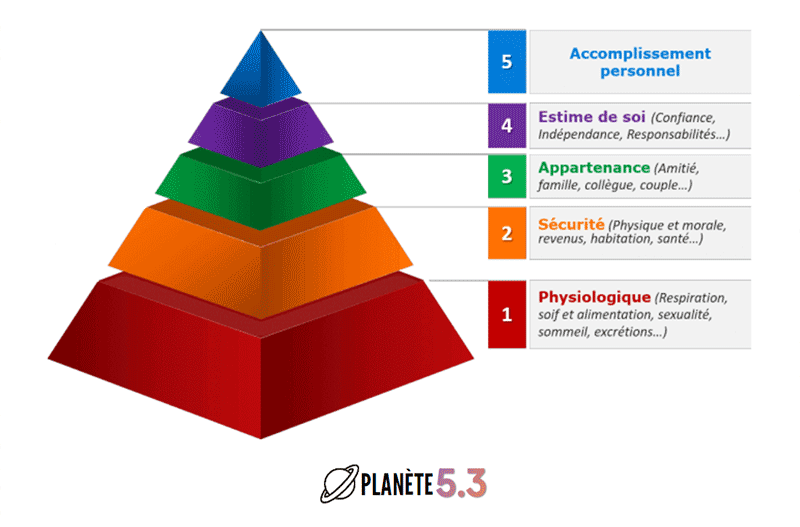Proposed by Abraham Maslow in the 1950s, the theory of the hierarchy of needs (or Maslow’s pyramid) aims to prioritize human needs according to their order of appearance in the individual. She is composed of five levels : physiological needs, the need for security, the need to belong, the need for esteem and the need for accomplishment.
In his theory, Maslow explains that the individual must satisfy the level 1 need before acquiring the motivation necessary to fulfill the level 2 need. This is valid for all five levels of the pyramid.
Although imperfect and often criticized, this motivational model remains the most popular because it is both logical and simple to explain. But it remains a theoretical model that has not been validated in practice.
At the individual level, we can use Maslow’s pyramid as a tool for self-knowledgeto determine what we can do, once we have reached a floor, to access the next level.

Physiological needs
The physiological needs constituting the base of the pyramid. They have the particularity of being linked to human survival as an individual or for the survival of the species. They are satisfied for most individuals. However, depending on the person, the effect felt by the fulfillment or not of one of these needs differs. This is how a person who appreciates clothes cannot be satisfied with the simple fact of just being dressed.
Some examples of physiological needs: breathing, eating, drinking, sleeping, dressing.
The need for security
The individual feels the need to protect himself and those close to him. THE need for security is complex, because the feeling of insecurity manifests itself differently depending on the individual. It also depends on factors such as health, family stability and income level.
Some examples of security needs: having housing, earning enough to meet your needs, starting a family, etc.
The need to belong
The need to belong represents the third level of Maslow’s pyramid. It revolves around the need for affection, love and social relationships. The individual feels the need to love and be loved and expresses the need to integrate a group, a community or to develop one’s circle of friends and relationships.
Examples of belonging needs: having friends, being in a relationship, building a family, but also campaigning for a cause, being a member of a club, a group or an association…
The need for esteem and recognition
The need for esteem is defined by a need for recognitionconsideration and self-confidence. It encompasses respect for others, personal esteem, reputation, consideration… The individual wishes to accomplish things which arouse the respect of those close to him, his colleagues, but also strangers and, if possible, the community entirely. These actions can be professional, sporting or even financial.
The need for self-actualization
Level five of Maslow’s pyramid is the need for achievement or self-realization. This need consists of realize oneself as an individual by exploiting its potential to the maximum. It can only be considered if the four previous needs are satisfied. Some examples of actions representative of this level: learn new things, acquire new skills, realize your dreams, create, become everything you can become.
The two forgotten floors
In his work, Maslow addresses two other categories of need. First the need for transcendence and spirituality, at the sixth level, which represents the need to surpass oneself humanly by forgetting oneself, by loving selflessly. We are not then concerned with doing things for ourselves but for something greater than ourselves (others, God, causes, ideas, etc.).
At the end of his life, Maslow added a seventh level, the aesthetic needthrough the search for beauty, the quest for creativity, the desire for harmony, etc.
These two additional levels are largely ignored in the Maslow pyramid that we know today. However, they are of public utility!













